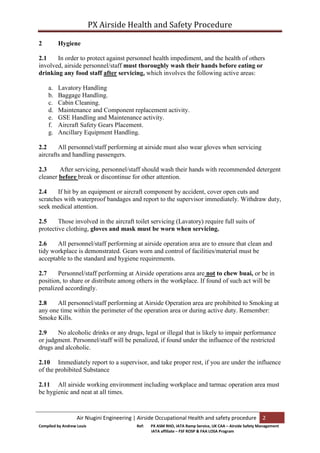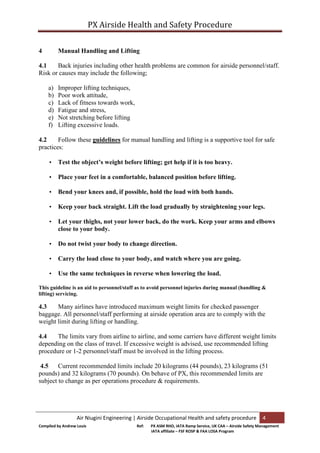Airside Occupational Health and Safety Procedure - 2015
- 1. PX Airside Health and Safety Procedure Air Niugini Engineering | Airside Occupational Health and safety procedure 1 Compiled by Andrew Louis Ref: PX ASM RHO, IATA Ramp Service, UK CAA – Airside Safety Management IATA affiliate – FSF ROSP & FAA LOSA Program Airside Occupational Health and Safety Procedure Four Fundamental Airside Occupational Health and Safety procedure, listed as follows; 1. Hearing Conversation (Workplace Communication) 2. Hygiene at Workplace (Clean and Tidy Working Environment) 3. Protective Clothing and Equipment Usage 4. Manuel Handling and Lifting Activity Procedures to be adhere! 1 Hearing Conservation 1.1 Tarmac (airside) is a high-noise area where the use of personal hearing protection is essential. 1.2 Airside personnel/staff must always use personal hearing protection gear that is approved by the Airline Operator for the specific operational task. 1.3 In addition to regular checks of their hearing protection apparatus, personnel should also have regular hearing tests. Regular, hearing test is compulsory. 1.4 All personnel/staff performing at airside are to be familiar and aware on how to handle and avoid serious injuries such as listed below; if one of the listed events occurred, refer to Manuals. a) Bleeding b) Fracture c) Burns & Scalds d) Eye Injuries e) Electric Shock 1.5 All personnel/staff performing at airside operation area are not to use any mobile devices and audio head phones. 1.6 No rough or boisterous playing and practical jokes which may lead to injury or damage that is likely to impair performance.
- 2. PX Airside Health and Safety Procedure Air Niugini Engineering | Airside Occupational Health and safety procedure 2 Compiled by Andrew Louis Ref: PX ASM RHO, IATA Ramp Service, UK CAA – Airside Safety Management IATA affiliate – FSF ROSP & FAA LOSA Program 2 Hygiene 2.1 In order to protect against personnel health impediment, and the health of others involved, airside personnel/staff must thoroughly wash their hands before eating or drinking any food staff after servicing, which involves the following active areas: a. Lavatory Handling b. Baggage Handling. c. Cabin Cleaning. d. Maintenance and Component replacement activity. e. GSE Handling and Maintenance activity. f. Aircraft Safety Gears Placement. g. Ancillary Equipment Handling. 2.2 All personnel/staff performing at airside must also wear gloves when servicing aircrafts and handling passengers. 2.3 After servicing, personnel/staff should wash their hands with recommended detergent cleaner before break or discontinue for other attention. 2.4 If hit by an equipment or aircraft component by accident, cover open cuts and scratches with waterproof bandages and report to the supervisor immediately. Withdraw duty, seek medical attention. 2.5 Those involved in the aircraft toilet servicing (Lavatory) require full suits of protective clothing, gloves and mask must be worn when servicing. 2.6 All personnel/staff performing at airside operation area are to ensure that clean and tidy workplace is demonstrated. Gears worn and control of facilities/material must be acceptable to the standard and hygiene requirements. 2.7 Personnel/staff performing at Airside operations area are not to chew buai, or be in position, to share or distribute among others in the workplace. If found of such act will be penalized accordingly. 2.8 All personnel/staff performing at Airside Operation area are prohibited to Smoking at any one time within the perimeter of the operation area or during active duty. Remember: Smoke Kills. 2.9 No alcoholic drinks or any drugs, legal or illegal that is likely to impair performance or judgment. Personnel/staff will be penalized, if found under the influence of the restricted drugs and alcoholic. 2.10 Immediately report to a supervisor, and take proper rest, if you are under the influence of the prohibited Substance 2.11 All airside working environment including workplace and tarmac operation area must be hygienic and neat at all times.
- 3. PX Airside Health and Safety Procedure Air Niugini Engineering | Airside Occupational Health and safety procedure 3 Compiled by Andrew Louis Ref: PX ASM RHO, IATA Ramp Service, UK CAA – Airside Safety Management IATA affiliate – FSF ROSP & FAA LOSA Program 2.12 During walkaround, servicing and maintenance activity ensure all FOD are considered and remove to make the working parameter clean and safe. 3 Protective Clothing and Equipment 3.1 All personnel/staff performing at Airside must wear full safety gears such as; a. Footwear, b. Gloves, c. Knee pads (if required) d. High-visibility clothing(vest), e. Toilet-servicing protective Suits f. Wet and winter weather jacket. (Rain Coat), g. Sun hats and sunglasses. h. Earmuffs and Ear plugs 3.2 High-visibility clothing or vest should be mandatory on the airside operation area. Clothing styles should fit comfortably to prevent becoming snagged. 3.3 All personnel/staff operating and handling equipment must be well trained, qualified, as well as physically and mentally be healthy and fit proper person to engage in airside activity. 3.4 All personnel/staff performing at airside must be aware of fire protection technique and preventive procedure. 3.5 It is compulsory; they have basic knowledge of the use of fire extinguisher and its emergency evacuation procedure in the event of fire or any event relating to fire. 3.6 It is mandatory; all personnel/staff operating at airside operation area must be trained on the operation and practice of ground and cabin fire evacuation procedure. 3.7 All personnel/staff performing at airside operation area, as equipment/vehicle operator must always drive within speed limit recommended by the Airport Authority. (Speed Limit: 10 KPH) 3.8 Gloves or other protective measures must be taken before Handling Dangerous Goods. If contracted with infectious substance, report immediately to the supervisor, seek medical attention ASAP. 3.9 During severe weather condition i.e. heavy downpour, thunderstorm & deluge stop aircraft servicing immediately. Do not run to reach shelter as wet environment and tarmac can cause harm or danger. 3.10 During higher wind and lightening thunder storms, all personnel/staff performing at airside operation area should not, a. Stay out in the open area, b. Take shelter under an aircraft, c. Load and unload explosive or flammable material.
- 4. PX Airside Health and Safety Procedure Air Niugini Engineering | Airside Occupational Health and safety procedure 4 Compiled by Andrew Louis Ref: PX ASM RHO, IATA Ramp Service, UK CAA – Airside Safety Management IATA affiliate – FSF ROSP & FAA LOSA Program 4 Manual Handling and Lifting 4.1 Back injuries including other health problems are common for airside personnel/staff. Risk or causes may include the following; a) Improper lifting techniques, b) Poor work attitude, c) Lack of fitness towards work, d) Fatigue and stress, e) Not stretching before lifting f) Lifting excessive loads. 4.2 Follow these guidelines for manual handling and lifting is a supportive tool for safe practices: • Test the object’s weight before lifting; get help if it is too heavy. • Place your feet in a comfortable, balanced position before lifting. • Bend your knees and, if possible, hold the load with both hands. • Keep your back straight. Lift the load gradually by straightening your legs. • Let your thighs, not your lower back, do the work. Keep your arms and elbows close to your body. • Do not twist your body to change direction. • Carry the load close to your body, and watch where you are going. • Use the same techniques in reverse when lowering the load. This guideline is an aid to personnel/staff as to avoid personnel injuries during manual (handling & lifting) servicing. 4.3 Many airlines have introduced maximum weight limits for checked passenger baggage. All personnel/staff performing at airside operation area are to comply with the weight limit during lifting or handling. 4.4 The limits vary from airline to airline, and some carriers have different weight limits depending on the class of travel. If excessive weight is advised, use recommended lifting procedure or 1-2 personnel/staff must be involved in the lifting process. 4.5 Current recommended limits include 20 kilograms (44 pounds), 23 kilograms (51 pounds) and 32 kilograms (70 pounds). On behave of PX, this recommended limits are subject to change as per operations procedure & requirements.
- 5. PX Airside Health and Safety Procedure Air Niugini Engineering | Airside Occupational Health and safety procedure 5 Compiled by Andrew Louis Ref: PX ASM RHO, IATA Ramp Service, UK CAA – Airside Safety Management IATA affiliate – FSF ROSP & FAA LOSA Program 4.6 Some airlines will accept heavier bags if the passenger pays an excess-baggage charge. . Therefore, however if excessive weight is advised, use recommended lifting procedure and technique. (i.e. application of mobile lifting Equipment) 4.8 Some items of baggage and cargo will exceed the given limits; consideration should be given to the use of motorized lifting equipment. 4.9 If baggage excessive load is not possible to be lifted, two-person lifting is essential. 4.10 During shift change over, all personnel/staff on the departing shift are not to execute duty in any way unless upon approval. 4.11 Proper rest is compulsory, if any signs of sickness, stress and fatigue, report immediately to the supervisor and take proper rest for further attention.




